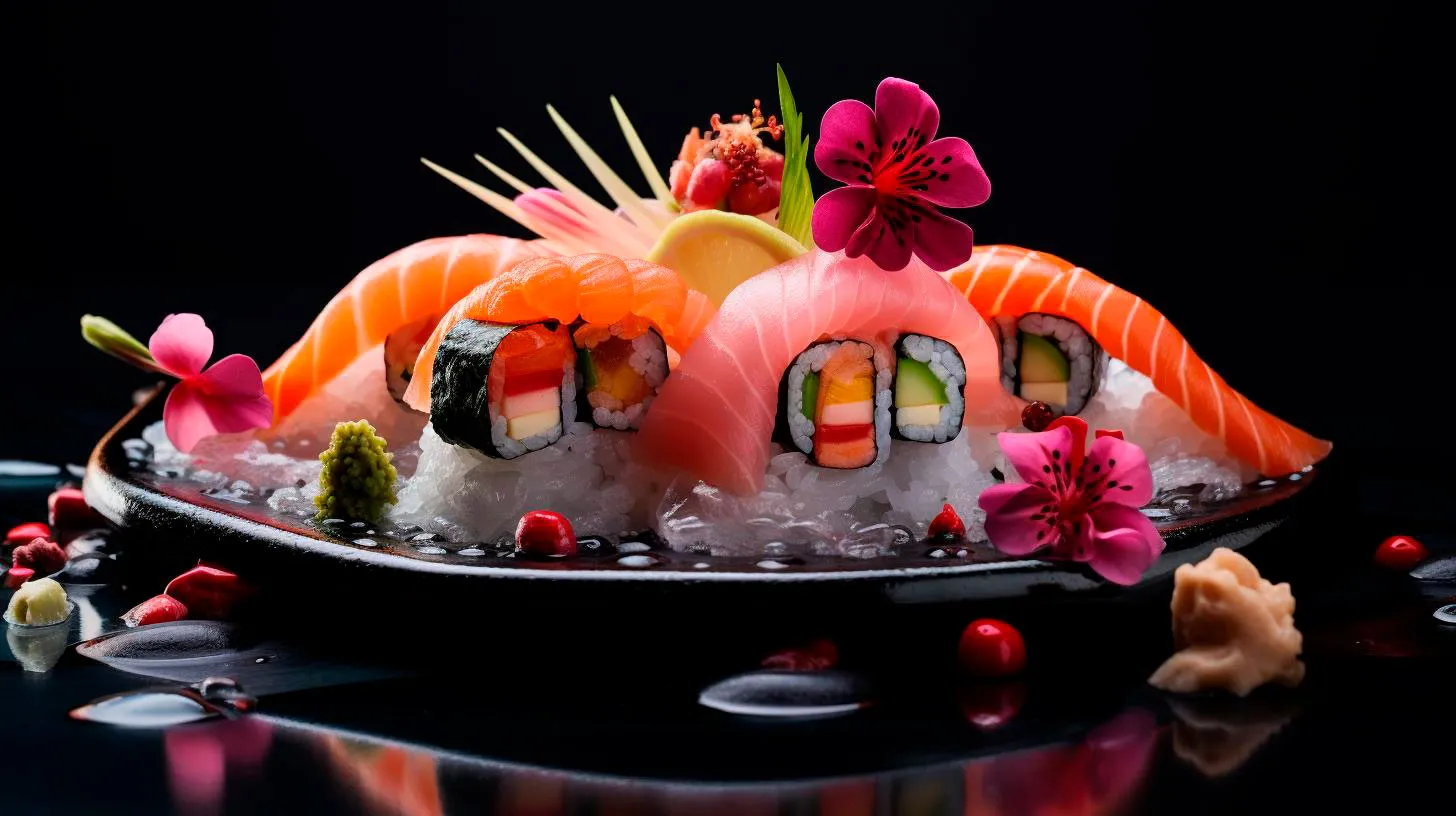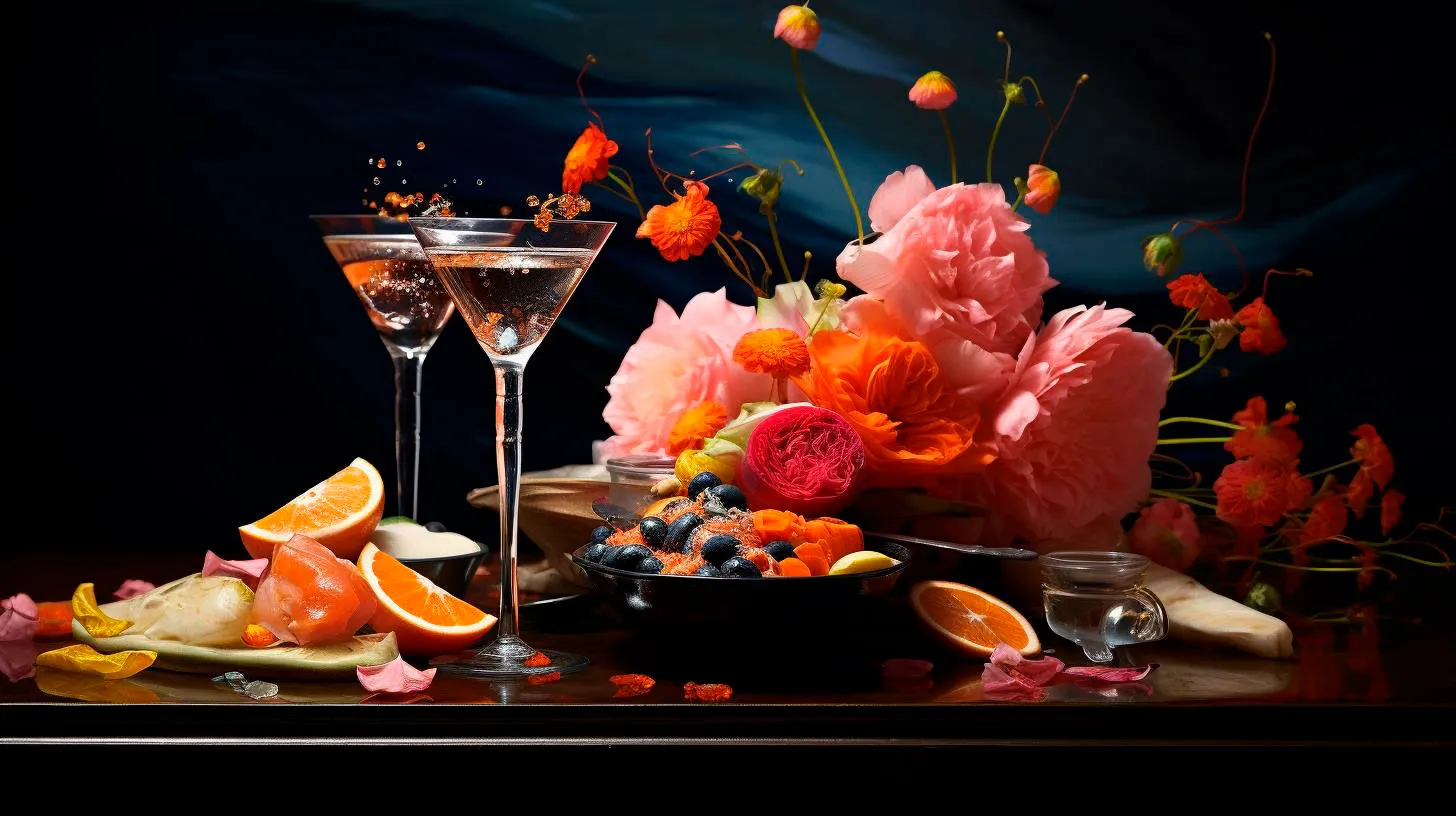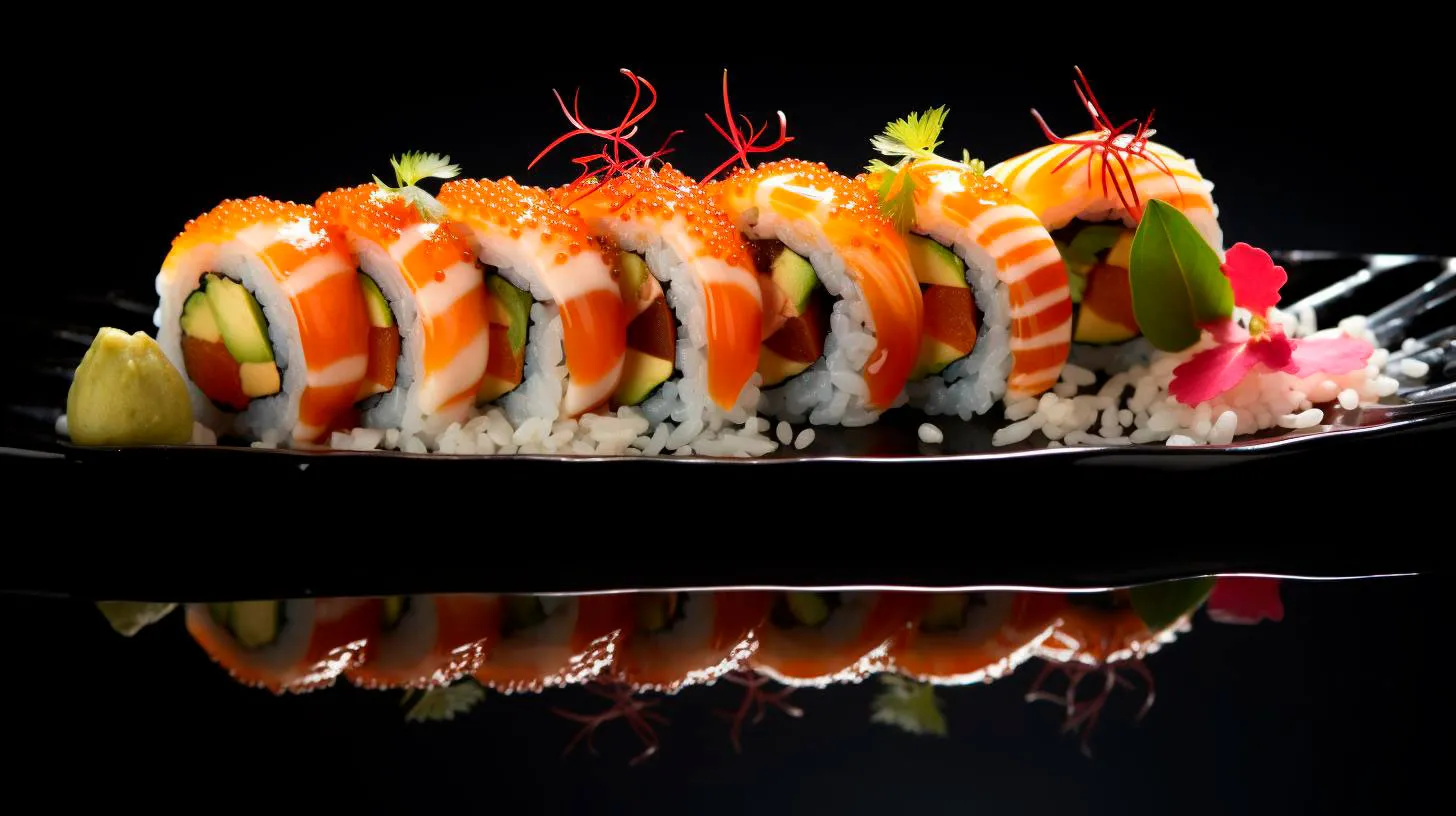From Novice to Pro: Learn the Art of Sushi Plating
In this article, we will guide you through the process of creating visually stunning and appetizing sushi presentations.
The Importance of Sushi Plating
Sushi plating is an essential aspect of Japanese cuisine. It is believed that the first bite is taken with the eyes, and an aesthetically pleasing sushi presentation can instantly captivate diners. A well-plated sushi dish not only showcases the chef’s skills but also adds excitement and anticipation to the dining experience. Furthermore, the arrangement of sushi can affect the overall texture and flavor balance of the dish.
Key Elements of Sushi Plating
1. Color Harmony: Strategically selecting ingredients with different colors can create a visually appealing contrast on the plate. For example, vibrant sashimi slices paired with freshly grated green wasabi can make your dish pop.
2. Texture Variety: Incorporating different textures into your sushi plating can make each bite more interesting. By combining crispy tempura, creamy avocado, and tender fish, you can create a harmonious balance of textures.
3. Balance and Proportion: Distributing the sushi rolls or nigiri evenly on the plate keeps the visual focus on the dish. Maintaining balance and proportion ensures that each piece receives equal attention.
4. Garnishes and Accents: Adding edible garnishes such as microgreens, colorful tobiko (flying fish roe), or thinly sliced Japanese pickles can elevate the aesthetics of your sushi plating.
Step-by-Step Guide to Sushi Plating
Step 1: Preparation
Gather all the necessary ingredients for your sushi dish, including fresh seafood, sushi rice, nori (seaweed), and any additional toppings or garnishes you desire. Ensure that all ingredients are properly sliced, rolled, or shaped before starting the plating process.
Step 2: Choosing the Perfect Plate
Consider the shape and color of the plate when selecting the perfect canvas for your sushi masterpiece. Traditional rectangular or oval-shaped plates are commonly used, but you can also experiment with unique shapes to add a modern touch to your plating style.
Step 3: Creating a Visual Layout
Begin by placing the main focus of your dish, such as a beautifully arranged sushi roll or nigiri, at the center of the plate. Surround it with complementary ingredients to create a visually appealing layout. Remember to leave ample negative space to allow each element to shine.
Step 4: Adding Garnishes and Accents
Amp up the visual appeal of your sushi plating by strategically placing garnishes and accents on and around the dish. Sprinkle some sesame seeds, drizzle a flavorful sauce, or scatter edible flowers for an attractive finishing touch.
Step 5: Final Touches and Presentation
Before serving, double-check the overall harmony and balance of your sushi plating. Ensure that the dishes are clean and free from any smudges or spills. Finally, present your culinary masterpiece with pride to your eager guests.
Advantages of Mastering Sushi Plating
- Enhances the overall dining experience and creates a lasting impression on guests
- Showcases your creativity and attention to detail as a sushi chef
- Increases the value and marketability of your restaurant or culinary skills
- Encourages diners to appreciate the visual and artistic elements of sushi
- Allows you to experiment and personalize your sushi presentations
Key Takeaways
Sushi plating goes beyond mere food arrangement; it is an opportunity to showcase your skills and creativity as a chef. By understanding the key elements of sushi plating and following a step-by-step guide, you can elevate your sushi presentations from novice to pro. Remember to experiment with color, texture, balance, and garnishes to create visually stunning dishes that leave a lasting impact on your diners. So, unleash your creativity and embark on a culinary journey to master the art of sushi plating!
The Art of Sushi Plating: Mastering Aesthetics
In this article, we will explore the art of sushi plating, highlighting its aesthetics and offering guidance on mastering this culinary skill.
The Importance of Sushi Plating
Sushi is not just a meal; it is an experience. The visual presentation of sushi enhances the overall dining experience, allowing the chef to showcase their creativity and attention to detail. A well-plated sushi dish not only entices the eater but also reflects the chef’s dedication towards the craft. Hence, mastering the art of sushi plating is crucial for any sushi chef or enthusiast.
Key Elements of Sushi Plating
Effective sushi plating involves several key elements that work together harmoniously to create a visually stunning dish. Let’s take a look at these essential components:
Color Palette
Colors play a vital role in sushi plating. A vibrant and well-balanced color palette can elevate the visual appeal of a dish. Sushi chefs often incorporate various ingredients such as fish, vegetables, and sauces of different colors to create an engaging and visually pleasing arrangement.
Balance and Symmetry
Balance and symmetry are crucial for sushi plating. Chefs strive to create visually symmetrical arrangements that are visually appealing and deliver a sense of harmony. A well-balanced dish ensures that each component complements the other, resulting in a satisfying and aesthetically pleasing presentation.
Texture and Shape
Texture and shape add depth and visual interest to sushi plating. Chefs skillfully manipulate the textures and shapes of various ingredients to create contrast and variation. For example, crispy tempura flakes alongside smooth fish slices or cubed vegetables alongside cylindrical rolls provide an exciting visual and textural experience.
Empty Spaces
The strategic use of empty spaces is a hallmark of traditional Japanese aesthetics. A well-plated sushi dish incorporates empty spaces to create a balanced composition. Empty spaces allow the focus to shift to the sushi itself, emphasizing its beauty and craftsmanship.
Mastering the Art of Sushi Plating
Becoming proficient in sushi plating requires practice, attention to detail, and an understanding of the principles mentioned above. Here are some tips to help you master the art of sushi plating:
- Study traditional Japanese art: Familiarize yourself with traditional Japanese art forms such as Ikebana (flower arrangement) or calligraphy. These art forms emphasize balance, minimalism, and aesthetics, providing valuable inspiration for sushi plating.
- Experiment with different ingredients: Incorporate a variety of colors, textures, and shapes in your sushi plating. Play around with different fruits, vegetables, and even edible flowers to create visually stunning arrangements.
- Invest in quality tableware: The choice of tableware can significantly impact the presentation of sushi. Opt for beautiful sushi plates and elegant chopstick holders to enhance the overall aesthetic appeal.
- Practice precision: Pay attention to the precision and consistency of your cuts. Uniformly sliced fish and precisely shaped rolls contribute to the overall visual appeal of the dish.
- Seek feedback: Share your sushi creations with experienced chefs or enthusiasts and seek constructive feedback. Empower yourself with insights to continuously improve your skills.
Conclusion
Sushi plating is a fascinating art that combines visual aesthetics with culinary expertise. The combination of vibrant colors, symmetrical arrangements, unique textures, and strategic use of empty spaces results in visually delightful dishes. As you embark on your journey to master the art of sushi plating, remember to experiment, seek inspiration from traditional Japanese aesthetics, and practice with precision. By doing so, you can elevate your sushi creations and offer a memorable dining experience that engages the senses.
Cooking School Secrets: Perfection in Sushi Plating Techniques
The Art of Sushi Plating
Plating sushi goes far beyond arranging raw fish and rice on a plate. It requires precision, skill, and a deep understanding of the art form. Masters of sushi plating not only aim to deliver an exquisite presentation, but they also aim to harmonize flavors and textures. Here are some secrets from the cooking schools that will help you master sushi plating:
1. Embrace Simplicity
Less is more when it comes to sushi plating. A clean and minimalist approach can enhance the beauty of the dish. Avoid overcrowding your plate and keep the focus on the sushi itself. By utilizing negative space, you can create a visually stunning presentation that captivates your guests.
2. Colors and Contrast
The vibrant colors found in sushi ingredients play a significant role in its visual appeal. Aim for a well-balanced color palette by incorporating different shades and hues. Contrast is also essential – a combination of dark and light elements creates a visually striking plate. For example, you can pair pale slices of sashimi with bright green wasabi and pickled ginger.
3. Balance and Symmetry
Symmetry is a fundamental principle in sushi plating. The careful arrangement of ingredients creates harmony and balance. There are various techniques, such as the “kanji-style” plating, where the sushi pieces are placed in perfect alignment. Experiment with different arrangements to find the one that suits your artistic vision.
4. Use Natural Elements
Bringing nature into your sushi plating can add a touch of elegance and authenticity. Incorporate natural elements like bamboo leaves, flowers, or even stones to create a beautiful visual display. These elements not only enhance the aesthetics but also connect the diner with the origins of sushi.
5. Play with Shapes and Texture
The shape and texture of the ingredients play a crucial role in sushi plating. Experiment with different shapes such as rolls, squares, triangles, or even abstract designs. Moreover, consider incorporating elements that provide texture contrast, such as crunchy tempura flakes or creamy avocado. This adds an exciting dimension to the dish and enhances the overall experience.
Advantages of Mastering Sushi Plating Techniques
Mastering sushi plating techniques can take your culinary skills to the next level. Here are the key advantages:
- Elevated Dining Experience: By presenting your sushi like a professional, you take your guests on a visual journey, enhancing their overall dining experience.
- Impress Your Guests: Thoughtfully plated sushi showcases your creativity and attention to detail, leaving a lasting impression on your friends and family.
- Instagram-Worthy: In today’s digital age, beautifully plated food gains attention on social media. Your sushi creations can become an online sensation, adding value to your personal brand or restaurant.
- Improved Palate Balancing: A well-plated sushi dish not only looks appealing but is also balanced in flavors and textures. This creates a more satisfying palate experience for the diners.
Key Takeaways
Sushi plating is an art that requires consideration of color, balance, symmetry, and texture. By embracing simplicity, utilizing natural elements, and being mindful of shapes and contrast, you can create stunning sushi presentations. Mastering sushi plating techniques not only enhances the dining experience but also provides opportunities for personal creativity and expression.
Next time you indulge in sushi, take a moment to appreciate the effort that goes into its presentation. The artful display adds another level of enjoyment to every bite. So, let your creativity flow, and elevate your sushi plating skills to create a memorable dining experience.
Unleashing Creativity: Elevating Sushi Presentation
In this article, we will explore the various ways sushi presentation has evolved and how it can be elevated to unleash the creative potential.
1. Beyond the Traditional
Traditionally, sushi has been served on plain plates with minimal garnishes. However, chefs are now experimenting with new presentation techniques to make their creations visually captivating. Here are a few techniques to take your sushi presentation to the next level:
- Using colorful and edible flowers as garnishes to add a pop of color and freshness
- Arranging sushi rolls in a creative pattern, such as a mosaic or wave design
- Using unique serving vessels, such as a wooden tray or a slate slab, to add a rustic touch
By thinking outside the box and incorporating these techniques, chefs can create a visual feast that not only delights the taste buds but also pleases the eyes.
2. Fusion of Flavors and Textures
Sushi is no longer limited to traditional ingredients. Chefs are experimenting with a fusion of flavors and textures to create unique taste experiences. Here are some exciting flavor combinations to consider:
- Spicy tuna topped with creamy avocado and crispy tempura flakes for a delightful contrast
- Seared salmon complemented by a tangy yuzu sauce and crunchy tobiko for a burst of flavors
- Mango and cucumber wrapped in soy paper, offering a refreshing and tropical twist
These innovative combinations not only elevate the taste of sushi but also add an element of surprise to its overall presentation.
3. Miniature Works of Art
With the rise of social media platforms like Instagram, sushi chefs have embraced the idea of creating miniature works of art. The meticulous attention to detail and intricate designs make for visually stunning sushi creations. Here are a few examples of how sushi can be transformed into art:
- Nigiri sushi arranged in the shape of a flower, resembling a beautiful bouquet
- Sushi rolls decorated with intricate patterns using different colored fish and vegetables
- Sashimi served in the shape of a dragon, showcasing the chef’s skill and creativity
These Instagram-worthy creations not only attract customers to sushi restaurants but also inspire other chefs to experiment and unleash their own creativity.
4. The Joy of Interactive Dining
Another trend in sushi presentation is the concept of interactive dining. Chefs are providing customers with a unique experience by allowing them to become part of the sushi-making process. Here are some interactive dining options you can find:
- Sushi rolling workshops, where customers can learn to make their own sushi rolls under the guidance of a chef
- Sushi conveyor belts where diners can choose their favorite sushi as it passes by
- Customizable sushi menus that allow customers to personalize their rolls with a wide selection of ingredients
By engaging the customers in the creation process, sushi restaurants not only enhance the dining experience but also encourage creativity and exploration.
In Conclusion
Sushi presentation has come a long way from its traditional roots. Chefs are continuously exploring new techniques, flavors, and interactive dining experiences to elevate the art of sushi. By unleashing creativity and embracing innovation, sushi has transformed into a true culinary masterpiece. So, the next time you visit a sushi restaurant, be prepared to be amazed by the visual feast that awaits you.



